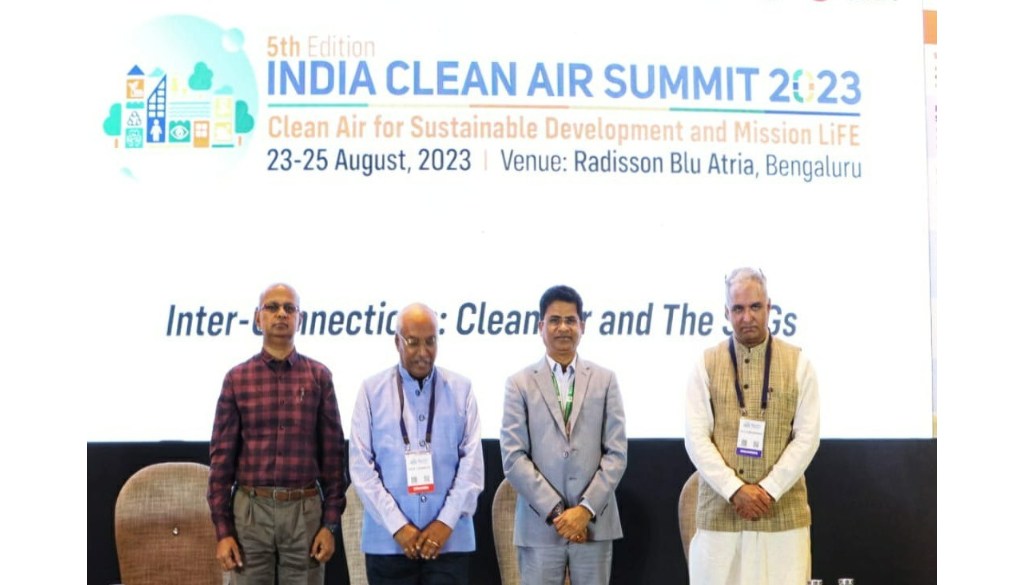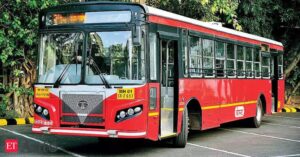Geo AI tech to monitor & predict air quality in Mumbai: ISRO Chair

Mumbai, 24 August 2023: The Geo Artificial Intelligence and Random Forest technologies will predict and monitor air quality in Mumbai and other Indian cities to help achieve Sustainable Development Goals (SDGs), informed Prof. P G Diwakar, ISRO Chair Professor, National Institute of Advance Studies while addressing the gathering at India Clean Air Summit (ICAS) 2023, a premier event on air pollution, organised by the Centre for Air Pollution Studies (CAPS) at the Center for Study of Science, Technology, and Policy (CSTEP).
Apart from Mumbai, the other Indian cities that will get covered will be Delhi, Chennai, Kolkata, etc. to help achieve Sustainable Development Goals (SDGs), informed Prof. P G Diwakar, ISRO Chair Professor, National Institute of Advance Studies while addressing the gathering at India Clean Air Summit (ICAS) 2023, a premier event on air pollution, organised by the Centre for Air Pollution Studies (CAPS) at the Center for Study of Science, Technology, and Policy (CSTEP).
Prof. Diwakar said that these computer-based tools are being harnessed in India to pool data from different sources. Already a pilot project has been initiated in Bengaluru.
“We must link up SDGs and air pollution agendas as highlighted by the United Nations. Using geospatial technology, we have well-distributed observation points about pollution on the ground. It should be strategically placed. When we do modelling of pollution, on how air pollution can be addressed, it is necessary to have a geospatial outlook and modelling from ground observations for Particulate Matter (PM), Nitrogen Oxides (NOx), (SOx), etc., and it could be linked to Aerosol Optical Depth (AOD). We need to bring in the weather data, wind speed, and wind direction that play a major role to be part of the model. The fractions concerning the roads do create a lot of polluting elements, and numerical models to build forecasting and assessment. We are also building AI models, and random forest theory, among others. These models from ground and space can be integrated for a better tomorrow and life,” Prof. Diwakar informed.
AI is the ability of a computer to do tasks that are usually done by humans, and for this, they require human intelligence and discernment. Whereas, Random Forest is a machine learning algorithm, which combines the output of multiple decision trees to reach a single result.
Detailing the project, Prof. Diwakar said: “We have initiated a pilot project in Bangalore and are actively assessing its effectiveness. Our aim is to extend this technology to predict and monitor air quality in heavily polluted cities such as Delhi, Mumbai, Chennai, Kolkata, and others. With unwavering confidence in our model’s capabilities, we will leverage historical data to predict and validate present air quality — an unprecedented feat in our country’s history. Our approach utilises conventional Artificial Neural Networks techniques, integrating diverse inputs from both space and ground sources to construct a robust predictive model. Spearheaded by the National Institute of Advanced Studies (NIAS), this project is set to be a collaborative effort among various groups.
Emphasising the crucial role of geospatial data, the model will operate within a comprehensive geospatial framework. All data will seamlessly integrate into the meticulously curated geospatial database. “As progress is made, the focus will extend beyond air pollution to encompass broader SDGs, addressing issues such as water pollution, electromagnetic radiation, and more. This holistic initiative reflects the commitment to pioneering transformative solutions that transcend conventional boundaries,” said Prof. Diwakar.
By taking the assistance of advanced technological interventions, India has seriously initiated the process to implement SDGs, and the results are getting noticed and acknowledged globally. For example, Prof V. Faye McNeill, Professor, Departments of Chemical Engineering and Earth and Environmental Sciences at Columbia University, has made certain observations with regard to India making major strides towards clean air and the groundwork being laid to achieve the goal.
“Since 2016, great progress has been made. Air pollution monitoring has expanded exponentially. There is PM2.5 monitoring done and not just only PM10. This monitoring is really the foundation and basis of the action plan. Public awareness is increasing across the country but we have somewhere to go. NCAP is a really huge milestone with over 130 cities across the country attempting to tackle air pollution. The number of days with an unhealthy air quality index is reducing. Neighbourhood level monitoring at the hyperlocal level can have high-level action towards air pollution abatement. There’s a lot of innovation happening in India towards clean air tools,” shared Prof. McNeill.
Speaking on the occasion, Selvi PK, Scientist, Central Pollution Control Board, said, “Within the expansive realm of SDGs, a staggering 248 indicators illuminate our path. When we assess and rank our nation, these indicators become our guiding stars. This comprehensive approach encompasses diverse dimensions, spanning from air and water quality to various forms of pollution. As custodians of pollution control, our mission aligns with the National Clean Air Program (NCAP) to curtail PM2.5 and PM10 by 30-40% by 2026.”
“Through innovative schemes like Extended Producer Responsibility (EPR), we’re tactfully reducing emissions across waste streams, whether it’s plastics or e-waste. Monitoring NCAP’s progress, Prana stands as a testament, ushering transparency through centralised data. This very mechanism, we believe, holds the potential to seamlessly oversee the entirety of our initiatives, including the broader canvas of SDGs,” Selvi added.
Addressing the gathering, Dr. Jai Asundi, Executive Director, CSTEP, said, “The idea behind the summit is to ensure engagement between academia and industry policymaking and other stakeholders in civil society to figure out that air pollution is a common problem for all to solve. Given the importance of air quality and what we are seeing in the ecosystem, we need to work on four pillars – measuring the air quality, modelling to understand the changes happening around us, policy engagement to understand the impact of air quality, and the latest thing is capacity building on how do we build capacity in our institutions in our society),”
Dia Mirza, Actress, and United Nations Environment Programme Ambassador, urged: “Traces of plastics are found in bloodstreams as well. Data indicates that the placenta is impacted directly due to air pollution and plastic impacting the growth of unborn babies. Sustainable Development Goals (SDGs) can be adopted at individual levels, we can find any individual action to mitigate pollution and poor air quality. Three actions: be aware of the waste we generate and scientifically dispose of the waste, reduce vehicular pollution by carpooling, and refuse single-use plastic.”
“Shedding light on India’s intricate airshed challenge, which possesses a diverse and complex structure, underscores the urgency of incorporating clean air objectives within our SDG framework (3, 9, 11, 17). The integration of clean air considerations is paramount, ensuring its prominence on our collective agenda. The essence of this summit lies in fostering a dynamic alliance among academia, industry, policy-makers, and civil society stakeholders. By recognising air pollution as a shared predicament, we strive for a unified solution. The current ecological landscape underscores the vitality of air quality. Framed within this context, our strategic approach must include precision in air quality assessment, dynamic modelling of environmental shifts, effective policy engagement that acknowledges air quality’s impact, and the emerging focus on capacity building, nurturing expertise within our institutions and society,” said Dr. Pratima Singh, Senior Research Scientist, Air Quality, CSTEP.
For this year’s India Clean Air Summit (ICAS) event, the Center for Study of Science, Technology, and Policy (CSTEP) partnered with the Indian Aerosol Science and Technology Organisation. ICAS2023 put the spotlight on pollution and its linkages to climate change and various sustainable development goals (SDGs) to help practitioners in the field explore opportunities for aligning clean air goals with climate policies. Prioritising clean air in the SDGs and in India’s policies for climate action is paramount, having acknowledged air pollution’s contribution to climate change and witnessing the aggravating impacts of climate change.
“We are confident that ICAS has triggered an inclusive dialogue that transcends boundaries, ensuring that clean air becomes an intrinsic part of our nation’s development trajectory and climate policy,” said Dr. Asundi, Executive Director, CSTEP.
Dr Chetan Singh Solanki, Professor, IIT Bombay, Founder | Energy Swaraj Foundation: Every year global warming is higher than expected. Energy generation and consumption has a correlation with all the SDGs. Even today 85% of our energy comes from coal, oil and gas. Every time we use energy, we are pumping carbon into the atmosphere. As a result of that, global warming is happening. Every part of our lives is also affected due to this.
Every country wants to produce and consume more, which is unsustainable. We need to localise the production. Centralised production results in inequitable distribution. We must abide by certain laws to limit our energy consumption first. Every government feels that producing more renewable energy, will solve the problem, which is wrong. It has an impact on the environment, though less than coal-generated power.
We must Avoid, Minimise and Generate (AMG):
1) Avoid the use of energy as much as possible, even if it is solar energy, by one-third.
2) Minimise the use of energy, by using efficient appliances. Try minimising consumption by at least one-third.
3) Generate one-third of energy locally, after following avoid and minimise steps.
Following this approach is universal.
If AMG is not done, then you will have to say OMG (Oh My God).




